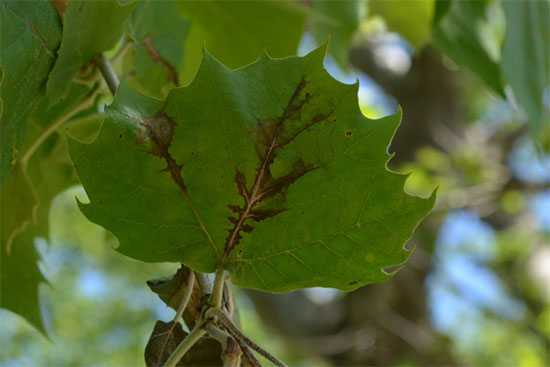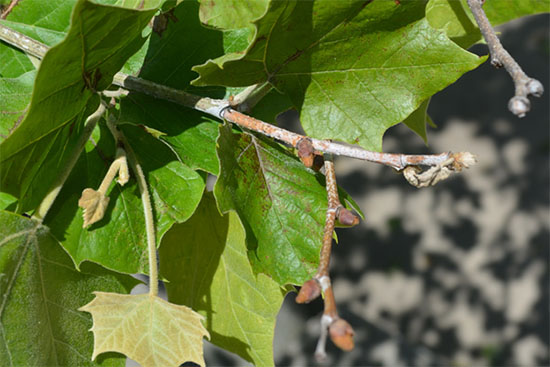Issue 5, May 23, 2016
Sycamore Anthracnose
Recent weather has provided ideal conditions for anthracnose diseases of shade trees. Sycamores are the most commonly affected trees in Illinois.
Sycamore Anthracnose occurs in three phases: canker, shoot blight, and leaf blight. The canker phase occurs in April and early May while the tree is dormant. This phase kills either individual buds or the tips of year-old shoots. Girdling cankers form just below the buds often killing them before the end of dormancy. Cankers can continue to enlarge, encircle and kill small shoots. The canker phase can be quite damaging, especially during springs with prolonged, cold temperatures that extend dormancy and allow the pathogen additional time to colonize bark and bud tissues.
Shoot blight describes the rapid death to newly expanding shoots and leaves. Shoot blight occurs either as the pathogen infects and kills the branch on which a new shoot was developing or as the pathogen enters succulent new growth. This phase often occurs during cold spring weather and can be confused with frost injury.
The leaf blight phase develops from fungal spores produced on cankers. Infections are most severe on the inner portions of lower branches where moisture remains the longest. Infected leaves develop brown lesions along the primary veins. As the fungus kills the primary veins, larger brown leaf areas die. The infection continues down the petiole and into the main shoots where it overwinters. Premature defoliation is common.

Sycamore anthracnose leaf blight lesions.
Cool moist weather during the two weeks following bud break favors both shoot blight and leaf blight phases. Serious infections are more likely to occur when the average temperature is between 50° and 55°F. In contrast, sycamore anthracnose infections are minimal if the average temperature is above 60°F.
In general, anthracnose diseases do not kill trees; but repeated infections can weaken trees, making them susceptible to other problems. Some defoliation may occur, but new leaves will emerge in warmer weather. Focus efforts on boosting tree vitality. Prune in and around the tree to open it to better air movement. Remove dead or dying branches. Water in periods of drought. Fertilize affected trees in the fall.

Twig killed by anthracnose during dormancy./em>
London planetree (Platanus x acerifolia) is a cross between the anthracnose susceptible Sycamore (Platanus occidentalis) and the anthracnose resistant Oriental Planetree (Platanus orientalis). 'Columbia', 'Liberty,' Exclamation!™ ('Morton Circle'), Ovation™ ('Morton Euclid') are several cultivars of London planetree that exhibit resistant to anthracnose.
Unless anthracnose fungi have repeatedly hit a tree or a very young tree is involved, we do not recommend using fungicides. Additionally, treatment may not practical for larger trees. Trunk injected fungicides are available and may be an option for high-value sycamore trees. (Travis Cleveland)
Author:
Travis Cleveland